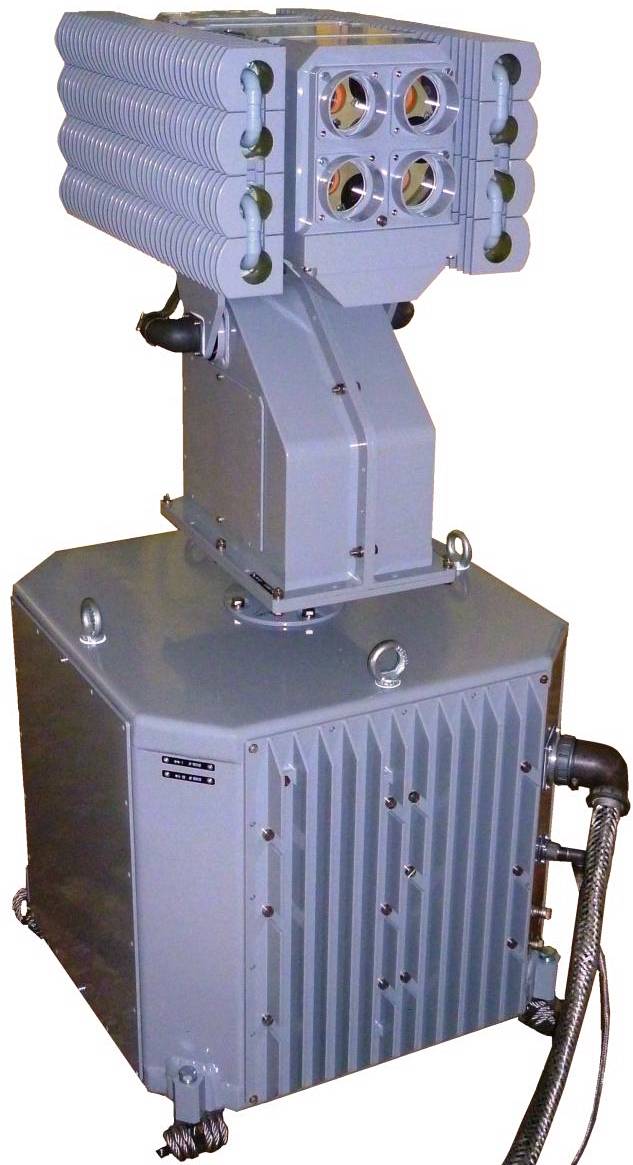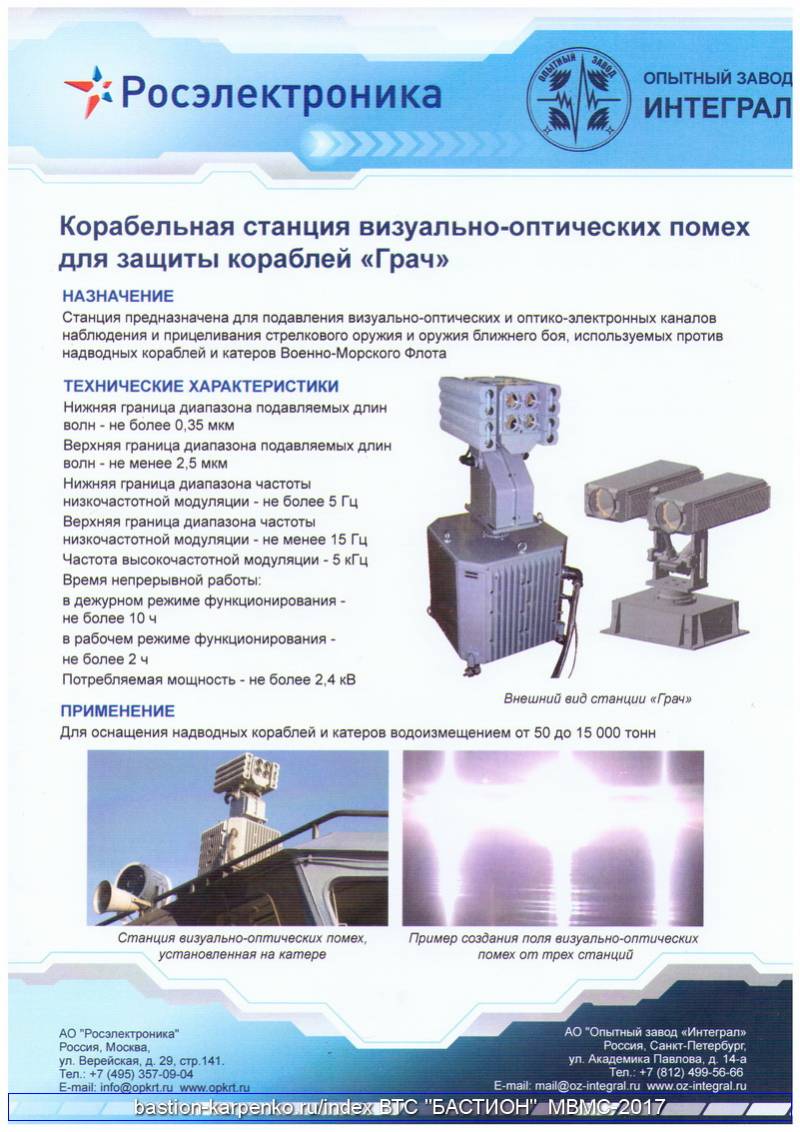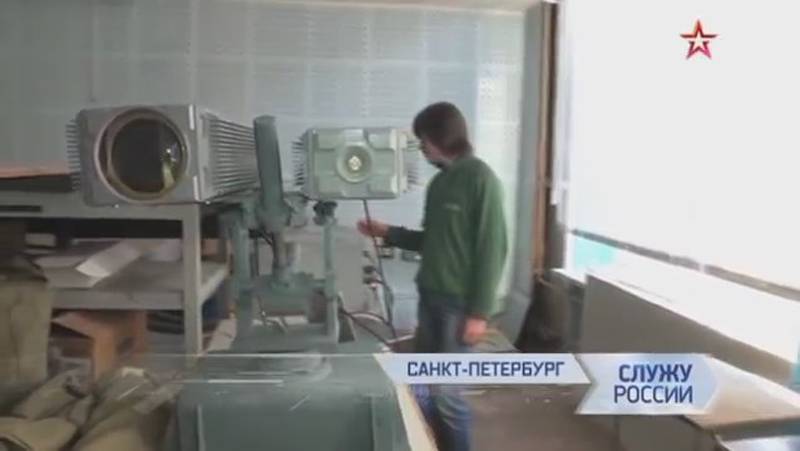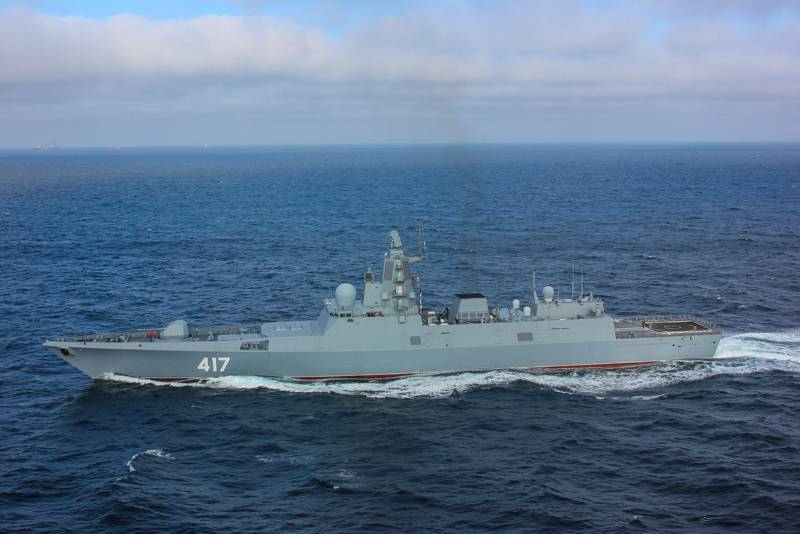"Filin" on the protection of the fleet
The family of visual optical interference stations is being developed by the Experimental Plant Integral JSC (St. Petersburg), which is part of the Rostec state corporation. The first sample of this kind, now known as 5P-42 "Filin", was presented several years ago. Its export version was shown at the International Navy Show in 2017, called 5P-42E Grach.

General view of the station 2П-42 "Filin". Photo of Experimental Plant Integral JSC / bmpd.livejournal.com
At the end of last year, Rostec announced the continuation of work on a new topic, and also announced the appearance of a prototype. The prototype of the Eagle Owl was due to appear in 2019. In early February, announced the installation of an experimental station on the frigate Admiral fleet Soviet Union Gorshkov. "
In the proposed form, the product "Filin" is a compact system suitable for installation on boats and ships with a displacement from 50 to 15000 thousand tons. The system is installed on any open area of the carrier, providing maximum visibility of the terrain. The station is designed to monitor the situation in the near zone and suppress enemy observers.
The 5P-42 product has a recognizable appearance. It received a polygonal case on which a turntable with a radiator unit is placed. In the presented configuration, the latter is a rectangular case with four spotlights. On the sides of the case are placed developed cooling system radiators. The design of the station allows for a circular alignment in the horizontal plane and to change the angle of elevation of the radiator. The complex also includes a control panel mounted in the interior of the carrier ship.
Four high power spotlights affect the target by frequency modulating the emission brightness. In other words, they constantly flash with different frequencies, which makes it impossible to effectively monitor the carrier "Filina". The emitter of the station suppresses the range with wavelengths from 0,35 to 2,5 μm - the visible part of the spectrum and part of the infrared. Low-frequency modulation is carried out within 5-15 Hz, high-frequency - 5 kHz. During operation, the 5П-42 station consumes no more than 2,4 kW.

Advertise export version of "Owl" called "Rook". Photo of JSC Experimental Plant Integral / bastion-karpenko.ru
Organization-developer provides interesting data on the impact of "Filina" on the target. During tests with the participation of volunteers, it was found that when working at distances up to 2 km in the sector width 10-15 hail. the station of visual and optical interference eliminates the normal operation of a person or electronics. The testers noted that the radiation of "Filin" does not allow to see the target and attack it with the help of small weapons. Half of the testers who tested the 5P-42 system on themselves noted a loss of orientation in space, dizziness, and other unpleasant symptoms. 20% testers also indicated the appearance of hallucinations.
The Filin station is also capable of suppressing night-vision devices, laser rangefinders of the infrared range, some guided weapon systems and other optical equipment. In their case, the effective range of the station reaches 5 km. Regardless of the type of target, maximum range values are achieved at dusk or at night.
The Filin station uses powerful sources of incoherent radiation, which gives some advantages over laser suppression systems. Floodlights have a greater dispersion and “cover” a larger area. In addition, the incoherent stream of limited power can interfere with observation, but does not lead to fatal consequences for optics or human vision. Thus, solving the tasks, the station 5П-42 is safe for others.
Another advantage of "Filin" over laser systems is its ability to work as a powerful searchlight. The station can highlight a given area or transmit light signals.

"Owl" while working. A frame from the "I Serve Russia", "Star" TV, 10 March, March 2019
TV channel "Star" showed how the station looks like interference in the dark. Before switching on the product, it was possible to consider the silhouette of the carrier ship, but after the emitters began to work, a significant part of the frame was covered with a bright spot. However, even on videotape it is extremely difficult to determine the location of the source of interference and the location of its carrier.
According to known data, to date, the station of visual and optical interference 5P-42 "Filin" received two Russian ships - these are the frigates "Admiral of the Soviet Navy Gorshkov" and "Admiral of the Navy Kasaton" of the 22350 project. Now two more ships of this type are at different stages of construction, and the Filin station will also be used in them. In the future, it is possible to install such products on other ships of the Russian Navy.
***
In recent materials of the Zvezda TV channel, curious data have appeared on the further development of visual-optical interference stations, which should lead to the emergence of a true family of such systems. The main ways for the development of stations, which provide for the addition of existing solutions with new ideas, have already been identified and are being worked out.
A new version of the station is being tested, with an upgraded emitter. In this project, two separate small-sized buildings are placed on the turntable, each of which carries one searchlight. The enterprises of "Roselectronics" have developed a variofocal lens for such a station, with the help of which it is proposed to change the total radiation power and change the range of work. It is expected that a station with such equipment will be able to “beat” on 3-4 km and operate in a sector up to 30 ° wide.

The new prototype of interference station from Integral. A frame from the "I Serve Russia", "Star" TV, 10 March, March 2019
In addition, new variants of jamming stations are being developed. In fact, we are talking about creating a whole family of samples with different capabilities and characteristics. The Integral enterprise plans to present in the market mountable, portable and wearable versions of stations of various kinds. The existing "Filin" is intended for surface ships, while promising samples will be able to work on any other platforms.
A characteristic problem of the existing stations of visual-optical interference of the type 5П-42 is the possibility of effective work only at dusk and at night. However, the issue of creating a station capable of solving assigned tasks during the day is already being worked out. It was found that such a product should use laser radiation. Due to the small width of the coherent beam, the prospective station needs special devices that will distinguish it from the “Filin” and its analogues.
The laser system is proposed to equip with special means that will deflect the beam; due to this, it will quickly “bypass” the sector of a given width and to some extent imitate the beam of a conventional searchlight. Such a station will be able to combine the positive qualities of existing samples and the advantages of a laser.
Prospective interference stations are planned to be supplemented by means of visual-optical intelligence and data transmission system. Due to this, they will be able to independently monitor the situation, find potentially dangerous objects and “attack” them. It is possible that the availability of data transmission facilities will allow the use of external target designation or transfer of target data to other carrier ship systems.

The frigate "Admiral of the Fleet of the Soviet Union Gorshkov" - the first carrier station "Filin" (at the time of the shooting is not installed). Photo of the Ministry of Defense of the Russian Federation / mil.ru
In the future, all new optical noise stations are planned to be introduced to the market. First of all, they will be offered to the domestic Ministry of Defense and foreign armies. Also reported on the interest from commercial structures. Non-lethal means of protection of objects may be necessary in the civil sphere. However, while the details of this kind are not reported.
***
Optical noise stations are already being operated on ships of the Russian Navy. Together with such equipment, ships receive some new features that are useful in certain circumstances. With their help, it is possible to ensure the protection of the near zone from various threats without resorting to the use of fire weapons.
During the work of the ships near the coast various incidents are possible. The enemy may try to sabotage: attack ships from the shore or use light watercraft to attack. To exclude a direct fire collision, or if it is impossible to accurately identify a threat, it makes sense to use non-lethal means. In this case, the attacker on the water or on the shore will not be able to observe, not to mention a direct attack.
Also, the 5P-42 system or other products of this kind can be used to counter enemy reconnaissance UAVs. Depending on the distance to such a target, the jamming station can interfere with the observation or even temporarily disable enemy optics. At the same time for such a goal does not have to spend ammunition anti-aircraft systems.
The station of visual optical interference of the type 5P-42 “Filin” is of great interest both for the Navy and for the ground forces. In some cases, the attack can be prevented and thwarted, preventing the enemy from carrying out surveillance. Interference stations are designed to solve such problems in the near zone and therefore can be useful in a number of real-world situations. Such equipment is already being used on Russian ships, and in the future new models with certain features are expected. It is very likely that the new jamming stations will be used in the Russian armed forces.
On the materials of the sites:
https://tvzvezda.ru/
https://tass.ru/
https://ria.ru/
https://rostec.ru/
https://bmpd.livejournal.com/
Information